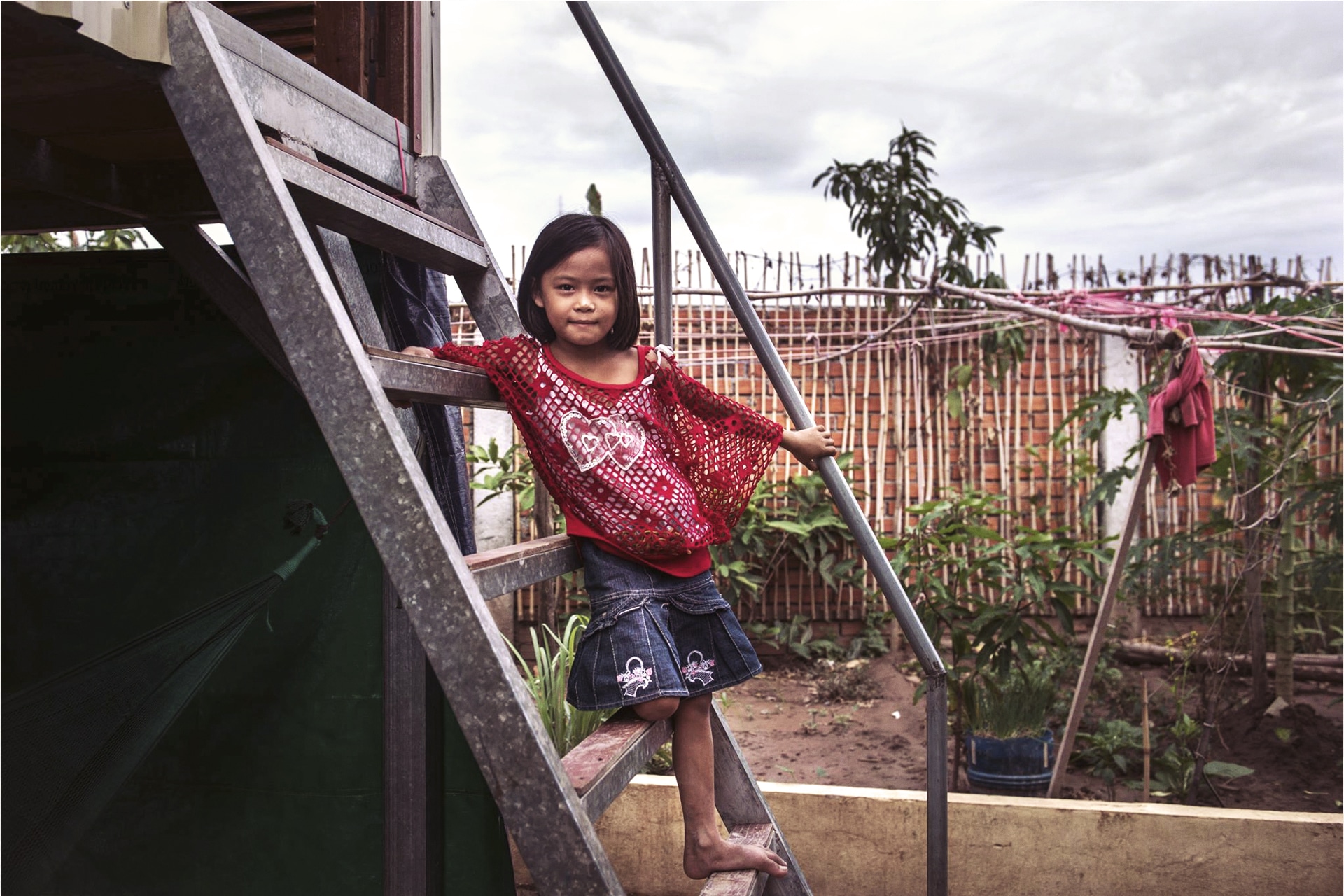July 27, 2014
TOMS for Houses
BY BARRY NEWMAN
The first thing Pete Dupuis asked his wife and daughter after he got home to Vancouver one evening in October, 2010, was: Do you know about TOMS? Dupuis, who was in a down year of a thirty-year career selling condominiums, had never heard of TOMS, the shoe brand, before his flight in from Los Angeles, but he’d gotten an earful about it from the hipster type who happened to sit next to him. The hipster was Blake Mycoskie, who founded TOMS, in 2006, on a promise to give away a pair of shoes to one of the world’s insufficiently shod for each pair of shoes it sold. Mycoskie had built TOMS into the fountainhead of for-profit, buy-one-give-one marketing. Its annual sales are currently said to be approaching three hundred million dollars.
Dupuis listened, and was “deeply moved,” he wrote later. His family’s closets, it turned out, were full of TOMS shoes, and the Web was full of Mycoskie: pictures of him kneeling before dark-skinned children, slipping TOMS shoes over their bare feet. Everyone in the the pictures was smiling (except, possibly, the village shoemaker). That night, Dupuis found himself wondering: Could he devise a way to make the sale of a luxury condo to a rich family in a rich country trigger the gift of a modest house to a poor family in a poor country? Could he, in other words, apply the buy-one-give-one stratagem to real estate?
He and Sid Landolt, his business partner, were soon feeling the entrepreneurial excitement of concepting a “big idea,” as Dupuis puts it in his literature. More than three years later, they have incorporated World Housing, based in Vancouver, which they describe as “the world’s first one-for-one real-estate gifting model.” In its first eight years, World Housing aims to shelter poor people in five thousand free houses that would cost fifteen million dollars to build; the money would come from the luxury developers who sign up to participate. The gifts would be set in motion by rich people, who would move into five thousand condominiums costing them more than three billion dollars to buy.
Dupuis stayed in touch with Mycoskie, receiving pointers via email. He summarizes one as follows: “Marketing should always be geared to create ‘top of the mind awareness,’ to leverage public relations, media, all social media tools, and your contacts to the fullest.” Which is why, on a slushy afternoon, Dupuis was in a booth at the Hudson Eatery, on West Fifty-Seventh Street, with two public-relations advisers, preparing to announce World Housing’s first “certified” condo: a twisted, fifty-two-story tower, still in the planning stage, to be built in Vancouver by the Canadian developer Westbank.
Dupuis, who is fifty-six, has the weathered look of someone who skis a lot. He ordered tea, with the bag on the side, and proffered a World Housing brochure. The slogan on the cover read, “Roofs over heads. People over poverty. Families over fear.” One of the P.R. reps called World Housing “a passion project.” Dupuis, who was letting his tea go cold, agreed. “It’s a passion for us,” he said.
The buy-one-give-one phenomenon (one-point-four million Google hits) hasn’t yet surpassed the buy-one-get-one-free phenomenon (three-point-four million hits), but it’s gaining ground. Eyeglasses and vitamins; blankets and comforters; dog beds and dog collars; candy bars and soap; fuzzy toys and woolly hats – buy one, and a poor man, woman, child, or dog will get one for nothing. Buy-one-give-one enterprises share a devotion to the goodness of profit and the profitability of goodness. When health workers in poor countries put on a free set of scrubs from FIGS (Fashion Inspires Global Sophistication), “their sense of self-worth and identity skyrockets.” OAK (Ordinary Acts of Kindness) gives a backpack to a poor kid for each one sold; the purchased backpacks have pouches for holding “a few dollars to give to a homeless person, tip a musician, or pay for a stranger’s beverage.”
Not every buy-one-give-one deal is evenly balanced. Project 7 won’t plant ten “fruit bearing trees into the Earth” until it sells twelve recycled test tubes of “Save the Earth Fresh Mints.” Before an Indian family gets one concrete water filter, Faucet Face must sell five of its glass water bottles. But for buy-one-give-one imbalances, World Housing seems destined to claim world leadership.
Dupuis and Landolt’s real-estate company, S&P Destination Properties, calls its inventory “the finest real estate in the finest places on earth.” In eight hours of a single day in 2006, the Honolulu Star-Bulletin reported, S&P sold units in the Trump International Hotel & Tower, in Waikiki, for a total of seven hundred million dollars. After the housing bust, its revenues dropped to two million dollars, in 2009, from forty-four million at the height of the bubble. All but forty-five of its two hundred and seventy staffers were let go, and Dupuis took two years off to write the master’s thesis that he had failed to submit in 1992. After meeting Mycoskie, he had his topic. Put simply: How can a real-estate guy from Canada give houses to poor people in poor countries? “Looking at Blake’s model, I knew my mission was to find the worst real estate in the world,” Dupuis wrote. A friend suggested, “It’s the people who live in garbage dumps.”
Dupuis flew out to see Scott Neeson, who runs the Cambodian Children’s Fund, a nonprofit that cares for children who work picking garbage in Phnom Penh. The dump where they and their families worked, Stung Meanchey, was closed in 2009, but the pickers still lived in and around it, in shacks made of scrap. Neeson agreed to lease land on the dump’s edge and rent it to responsible pickers, at a subsidized rate of about twenty dollars a month. Dupui with a million dollars in seed money from a group of like-minded contacts has paid to build a workshop that hires some of the pickers, selected by Neeson, to assemble the new houses. World Housing pays for the materials, which cost twenty-five hundred dollars per house. Families moved into the first five homes last year. Dupuis wants to build fifty houses a month in Phnom Penh. He’s scouting other dumps, too, in the Philippines and Mexico.
At several nongovernmental organizations, specialists in the complexities of developing-country slums had doubts about World Housing’s ambition to keep expanding as long as there are poor people and condominiums. Slum dwellers generally have no shortage of materials to build their own homes. They don’t build nicer houses of the kind that Dupuis has designed because what they lack, more than materials, is security. Many are squatters. Those who rent homes face eviction at any time.
At the Hudson Eatery, Dupuis was prepared to respond to such misgivings. He reached into a bag and pulled out a clear plastic cube containing an architect’s model of a World Housing house, decorated with little green trees. Made of corrugated dark-green steel and set upon stilts, the full version is the size of a suburban garden shed, with a solar panel on the roof to power a light bulb. “We’re O.K. if they’re squatters,” Dupuis said. “These homes can be disassembled. We go in there, unbolt the thing, find another piece of land, and move the family. We’ll hit some bumps,” he went on. “That’s O.K. My life’s been a bunch of bumps. It’s just one more bump.”
Back in North America, developers and house hunters are going to need persuading. “We’ve had our noses bloodied by developers all over,” Dupuis said. “They are very single-minded. We’re finding some who understand that we’d make projects more marketable.”
Dupuis conducted an online survey for his thesis, to gauge World Housing’s prospects. One developer wrote that the developer would be seen as having a moral conscience. A condo owner wrote, “The one-for-one idea is THE most important part of the gifting. People see that when they buy a home and their life changes, a deserving family receives a home and their life changes. You can’t touch this part!”
Still, a cohort of developers worried that the one-for-one approach would not work as well for home buyers as it had for shoe buyers. “I have a concern that people may think they are paying more for the condo,” one wrote. Dupuis explains in his thesis that he and Landolt finally decided to “reduce the risk of non-participation by not requiring the buyer to make a financial contribution.”
For every sale, instead, the developers themselves will pay World Housing three thousand dollars (including a service fee) and account for it as a marketing expense. That way, a buyer of a million-dollar condo won’t have reason to think that it was worth only nine hundred and ninety-seven thousand. Since the selfless choice of a World Housing property activates the funding, buyers can still feel generous.
Condo families, Dupuis said, would receive snapshots of their corresponding dump families, and would be welcome to pay them a visit. “People visiting slums is the fastest-growing sector of third-world tourism,” he said, putting his model house back in its bag. (“It’s called “poorism,” – one of his P.R. reps explained.)
There is no telling whether World Housing will succeed on a grand scale, but its appeal to condo buyers has been given a test run. For one week, last June, a developer let Dupuis and Landolt market seventy apartments with their buy-one-give-one pitch, on behalf of the pickers in Phnom Penh. The apartments were in a condo hotel under construction in Waikiki, a block from the beach. The prices ranged from nine hundred thousand to fifteen million dollars. The Web site for the building shows sunset views of elegant couples embracing on balconies: “It is a world you never want to leave and long to return to.”
The World Housing apartments in the building quickly sold out. Dupuis wanted to include the name of the international luxury hotel chain that manages the condotel in his publicity blast, but “they asked us not to,” he said. “They didn’t want pictures of their project next to pictures of kids in garbage dumps.” He added, “It’s awkward, I guess.”
Barry Newman, a former feature writer and foreign correspondent for The Wall Street Journal, is working on a collection of his stories, with essays on how he got them, for CUNY Journalism Press.
An earlier version of this piece incorrectly identified a Canadian developer as Westgate. The developer is called Westbank.
Illustration by Matthew Hollister.




